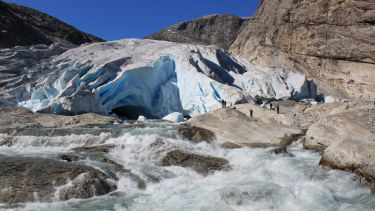-
New analysis demonstrates the importance of glacier flow speed and local climate
-
Findings overturn earlier research, showing that erosion rates do not increase with the speed of glacier flow as quickly as previously anticipated
-
University of Sheffield research will help to identify suitable sites for the safe long-term storage of hazardous nuclear waste
New insights into rates of bedrock erosion by glaciers around the world will help to identify better sites for the safe storage of nuclear waste, according to researchers.
A new analysis of global glacier erosion rates and flow speeds by scientists at the University of Sheffield, University of Dundee and Keele University has overturned previous findings about the link between glacial flow and erosion rates.
Published in Nature Communications today (6 February 2020), the findings confirm the importance of glacier flow speed in determining the rate of glacial erosion. But in an unexpected result, the scientists show that the increase in erosion rate with glacier flow speed occurs much more slowly than previously thought.
Dr Darrel Swift, a member of the Energy Institute at the University of Sheffield, said: “As glaciers flow downhill, they slide over the bedrock beneath, causing the bedrock to be eroded. This analysis shows that a glacier that flows twice as fast as its neighbour does not necessarily produce twice the rate of bedrock erosion.
“This may be because, as glacier flow speed increases, spaces between the ice and the bed are formed in the lee of bedrock bumps. This means that the base of the glacier begins to separate from, or lose contact with, the bed.
“This effect has been suggested by some to enhance the rate of erosion, because it increases the stress placed by sliding ice on the few lumps of bedrock that remain in contact with the glacier’s base. However, it is perfectly possible that this effect is negated by the fact that less and less of the bed is in contact with sliding ice.”
For the first time, the analysis also shows the clear importance of local temperature and precipitation in determining glacial erosion rates at the global scale.
Dr Swift explained: “The speed of glacier flow is important because this dictates how fast ice at the base of the glacier slides over the bedrock beneath.
“But a glacier also has to keep its bed clean. This is because sediment produced by erosion can accumulate at the glacier bed, and the accumulation of a thick sediment layer would eventually slow the rate of erosion. Warmer and wetter environments may help glaciers to wash their beds because glacial melt will likely be more abundant, and this means sliding ice will maintain closer contact with bedrock.”
The findings help to explain patterns of glacial erosion produced by glaciers and larger ice caps or ice sheets, which are responsible for creating spectacular Alpine landscapes – and also have implications for the safe long-term storage of hazardous nuclear waste.
Dr Swift, who has advised organisations responsible for the siting and development of deep geological nuclear waste disposal facilities, said: “For many countries, underground storage of hazardous nuclear waste in a deep geological facility is the accepted safest solution. Organisations responsible for finding suitable sites for these facilities, and for designing the necessary underground infrastructure, must ensure that future glacial erosion will not adversely affect the facility’s integrity.
“Advancing ice during future glacial periods could, over many hundreds of thousands of years, remove many hundreds of metres of bedrock. This would likely affect the environment of the disposal facility beneath, where nuclear waste can remain dangerous for over 100,000 years.
“In many countries, otherwise ideal sites for the development of deep geological disposal facilities are in areas that have previously been covered by ice. This means that those sites will likely experience glaciation, and glacial erosion, in the future.”
The Energy Institute at the University of Sheffield carries out energy research across a wide spectrum of fields, including renewable, nuclear and conventional energy generation, energy storage, energy use and carbon capture, utilisation and storage technology. Its multi- and interdisciplinary research teams work with industry and government on sustainable solutions.
Contact: Sophie Armour, Media & PR Officer at the University of Sheffield: 07751 400 287 / 0114 222 3687 / sophie.armour@sheffield.ac.uk

